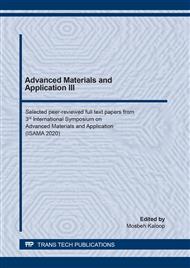[1]
R. F. Gonzales, M. Calero, Effective removal of zinc from industrial plating wastewater using hydrolyzed olive cake: Scale-up and preparation of zinc-based biochar, J. Clean. Prod. 227 (2019) 634-644.
DOI: 10.1016/j.jclepro.2019.04.195
Google Scholar
[2]
V. D. A. Cardoso, A. G. de Souza, P. P. Sartoratto, L. M. Nunes, The ionic exchange process of cobalt, nickel and copper (II) in alkaline and acid-layered titanates, Colloids Surf. A Physicochem. Eng. Asp. 248(1-3) (2004) 145-149.
DOI: 10.1016/j.colsurfa.2004.09.012
Google Scholar
[3]
M. Ye, G. Li, P. Yan, J. Ren, L. Zheng, D. Han, S. Sun, S. Huang, Y. Zhong, Removal of metals from lead-zinc mine tailings using bioleaching and followed by sulfide precipitation, Chemosphere, 185 (2017) 1189-1196.
DOI: 10.1016/j.chemosphere.2017.07.124
Google Scholar
[4]
J. E. Efome, D. Rana, T. Matsuura, C. Q. Lan, Effect of operating parameters and coexisting ions on the efficiency of heavy metal ions removal by nano-fibrous metal-organic framework membrane filtration process, Sci. Total Environ. 674 (2019) 355-362.
DOI: 10.1016/j.scitotenv.2019.04.187
Google Scholar
[5]
T. K. Tran, K. F. Chiu, C. Y. Lin, H. J. Leu, Electrochemical treatment of wastewater: Selectivity of the heavy metals removal process, Int. J. Hydro. Energy, 42(45) (2017) 27741-27748.
DOI: 10.1016/j.ijhydene.2017.05.156
Google Scholar
[6]
M. Sillanpaa, M.C, Ncibi, A. Matilainen, M. Vepsalainen, Removal of natural organic matter in drinking water treatment by coagulation: A comprehensive review, Chemosphere, 190 (2018) 54-71.
DOI: 10.1016/j.chemosphere.2017.09.113
Google Scholar
[7]
S. Gogoi, S. Chakraborty, M. D Saikia, Surface modified pineapple crown leaf for adsorption of Cr(VI) and Cr(III) ions from aqueous solution, J. Environ. Chem. Eng. 6(2) (2018) 2492-2501.
DOI: 10.1016/j.jece.2018.03.040
Google Scholar
[8]
W. Astuti, T. Sulistyaningsih, E. Kusumastuti, G. Y. R. S. Thomas, R. Y. Kusnadi, Thermal conversion of pineapple crown leaf waste to magnetized activated carbon for dye removal, Biores. Technol. 287( (2019) 121426.
DOI: 10.1016/j.biortech.2019.121426
Google Scholar
[9]
E. Yagmur, Y. Gokce, S. Tekin, N.I. Semerci, Z. Aktas, Characteristics and comparison of activated carbons prepared from oleaster (Elaeagnus angustifolia L.) fruit using KOH and ZnCl2, Fuel, 267 (2020) 117232.
DOI: 10.1016/j.fuel.2020.117232
Google Scholar
[10]
O. Oginni, K. Singh, G. Oporto, B. D. Andoh, L. McDonald, E. Sabolsky, Effect of one-step and two step H3PO4 activation on activated carbon characteristic, Biores. Technol. Rep. 8 (2019) 100307.
DOI: 10.1016/j.biteb.2019.100307
Google Scholar
[11]
W. Astuti, R. A. Hermawan, H. Mukti, N. R. Sugiyono, Preparation of activation carbon from mangrove propagule waste by H3PO4 activation for Pb2+ adsorption, AIP. Conf. Proc. 1788(1) (2017) 030082.
DOI: 10.1063/1.4968335
Google Scholar
[12]
L. Yue, Q. Xia, L. Wang, L. Wang, H. DaCosta, J. Yang, X. Hu, CO2 adsorption at nitrogen-doped carbons prepared by K2CO3 activation of urea-modified coconut shell, J. Colloid Interf. Sci. 511 (2018) 259-267.
DOI: 10.1016/j.jcis.2017.09.040
Google Scholar
[13]
K. K. Beltrame, A. L Cazetta, P. S. de Souza, L. Spessato, T. L. Silva, V. C Almeida, Adsorption of caffeine on mesoporous activated carbon fibers prepared from pineapple plant leaves, Ecotox. Environ. Safe. 147 (2018) 64-71.
DOI: 10.1016/j.ecoenv.2017.08.034
Google Scholar
[14]
S. Y. Gu, C. T. Hsieh, Y. A. Gandomi, Z. F. Yang, L. Li, C. C. Fu, R. S. Juang, Functionalization of activated carbon with magnetic Iron oxide nanoparticles for removal of copper ions from aqueous solution, J. Mol. Liq. 277 (2019) 499-505.
DOI: 10.1016/j.molliq.2018.12.018
Google Scholar
[15]
E. Altintig, H. Altundag, M. Tuzen, A. Sari, Effective removal methylene blue from aqueous solutions using magnetic loaded activated carbon as novel adsorbent, Chem. Eng. Res. Des. 122 (2017) 151-163.
DOI: 10.1016/j.cherd.2017.03.035
Google Scholar


